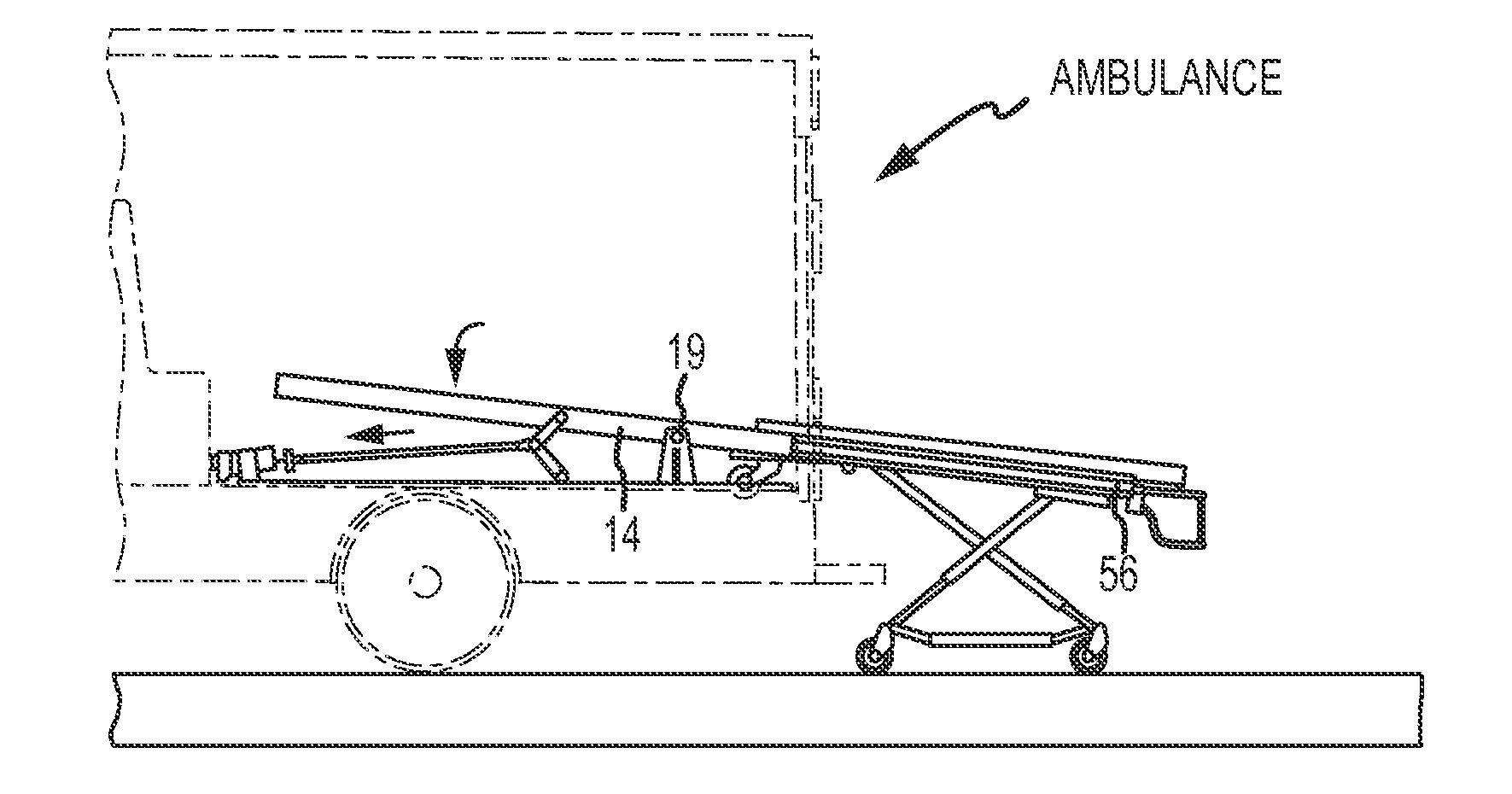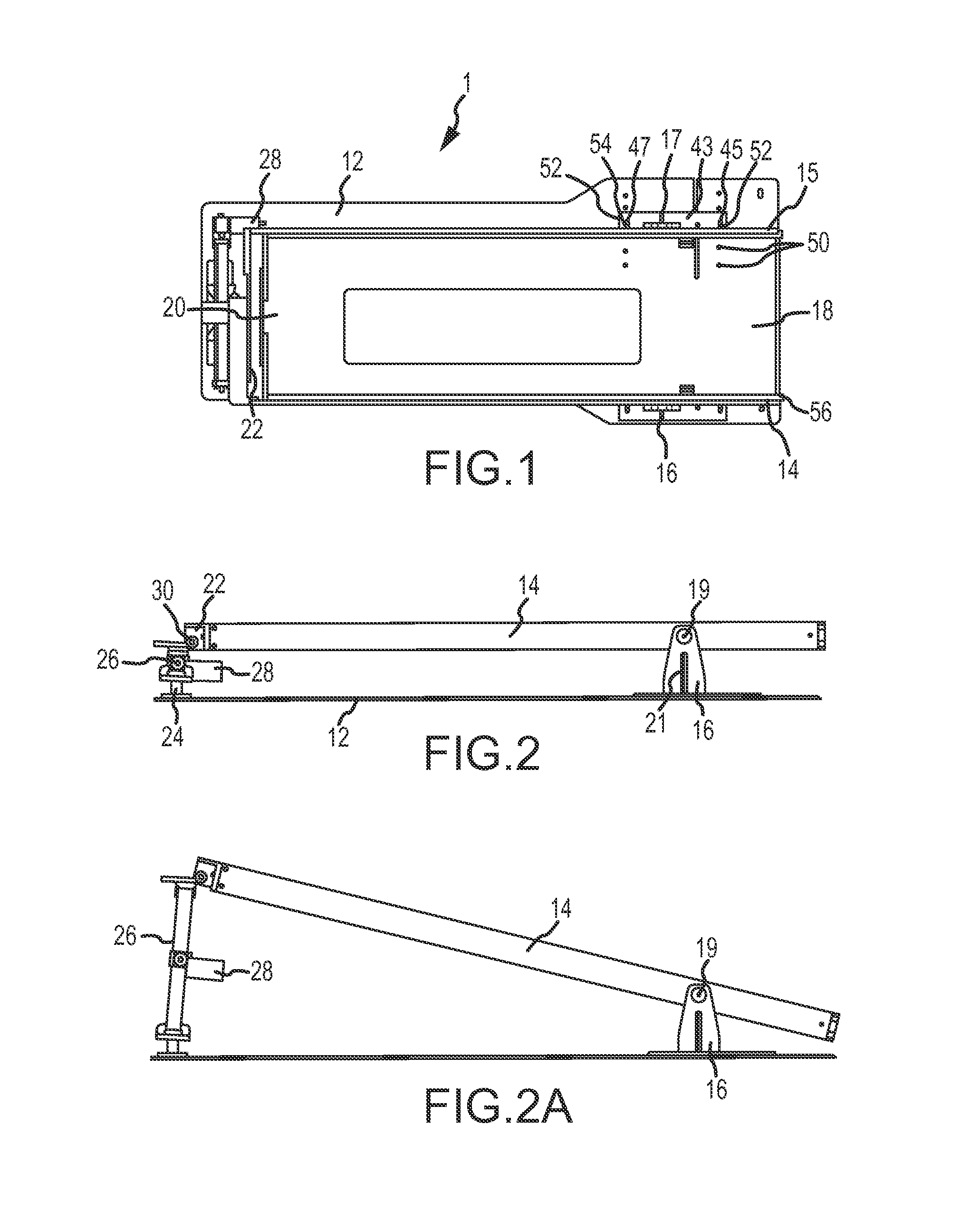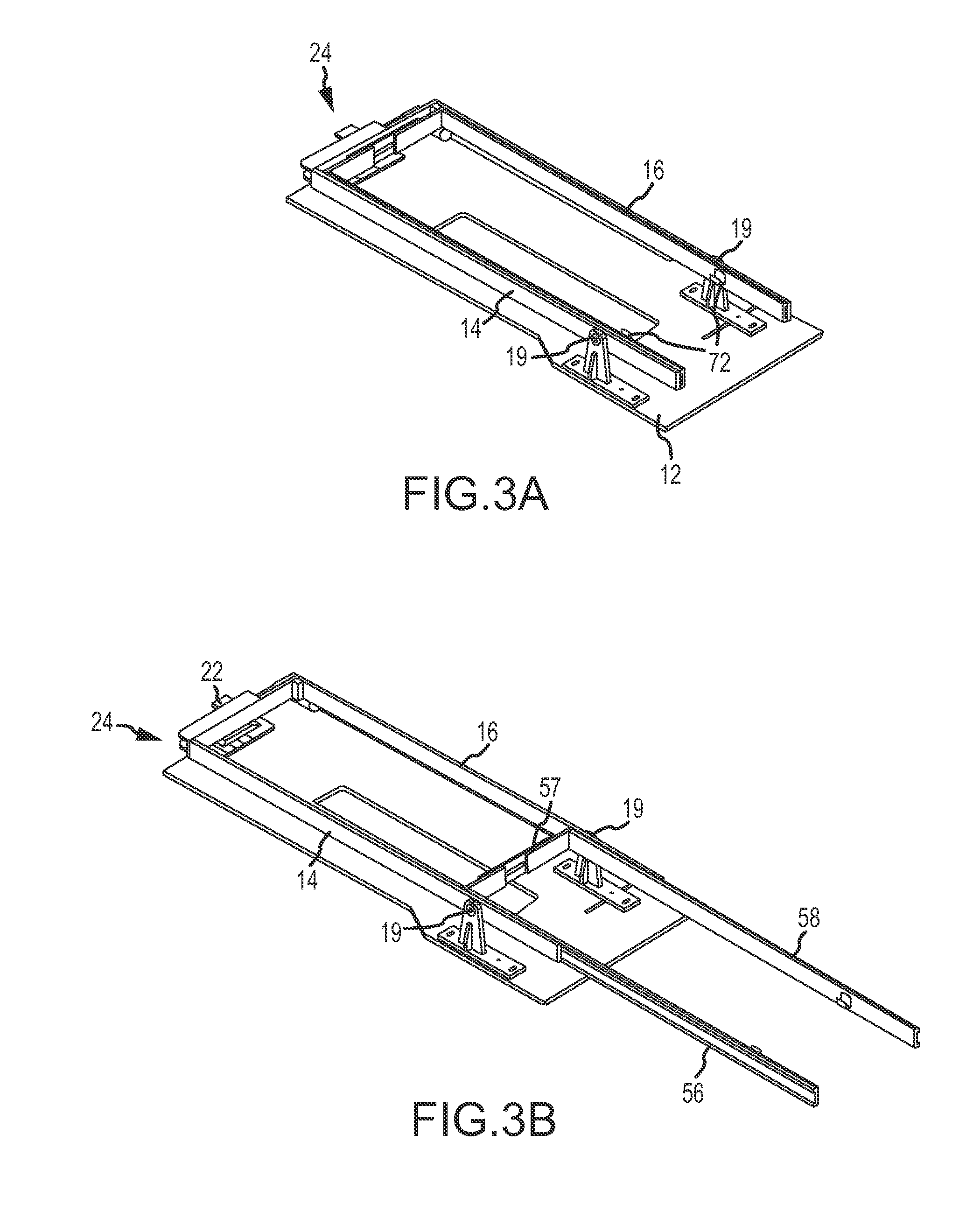System and method for transferring a wheeled load into a transport vehicle
a technology for transferring a wheeled load and a transport vehicle, which is applied in the direction of transportation items, loading/unloading vehicle arrangment, refuse collection, etc., can solve the problems of not being able to provide any rest support for the stretcher, the operator is subject to a considerable physical strain, and the health operator is seriously injured during the operation, etc., to achieve a simple, inexpensive, and adjustable effect of the patient transport li
Inactive Publication Date: 2012-09-20
MONTROSE INNOVATIONS
View PDF0 Cites 36 Cited by
- Summary
- Abstract
- Description
- Claims
- Application Information
AI Technical Summary
Benefits of technology
[0015]The present invention provides among other things a simplified, inexpensive, adjustable patient transport lift system and a method of transferring a load on a transport into a vehicle. More specifically, the lift system provides a pair of rails that may be adjusted to accommodate any cot currently in use by an ambulance. The rail system is extendable and is operated by a linear actuator, a winch, a spring system or some combination to couple to a cot or other transport and lift the cot or other transport to a height from which the cot may be laterally inserted into the ambulance without undue strain on the EMT, firefighter, or other user.
[0017]It is an object of the invention to provide a lift system that prevents undue strain on EMT and other personnel charged with loading a load on a transport into a vehicle. It is another object of the invention to provide a simple linear actuator mechanism to load a cot onto an ambulance. It is another object of the invention to provide a lift mechanism that may be adjusted for use with existing cots used in ambulances in the industry. It is another object of the invention to provide a method for safely and securely transferring a load on a transport into a vehicle by lifting the load with a linear actuator system to a height sufficient to laterally insert the transport into the vehicle.
[0019]In one embodiment, the system includes a first and a second rail coupled to the ambulance at a brace and an axle. The brace, the axle, or both the brace and the axle may each be a single structure that spans the gap between the first rail and the second rail. The gap between the first rail and the second rail may be adjustable to accommodate any sized cot support frame. The axle of the rails may be supported on a leg that is adjustable with respect to its position relative to the floor of the ambulance. The leg may be adjusted in a direction perpendicular to the alignment of the rails, to allow the width between the rails to be customized.
[0042]In one embodiment of the invention, the device is fitted with enhanced safety features, comprising lights, reflectors, warning labels and devices, and any device known to one skilled in the art to enhance safety of operations involving cots and related emergency care, in particular emergency care as related to loading and unloading of patients via cots into and out of ambulance vehicles.
Problems solved by technology
Still, however, current practice requires the operators of the ambulance to physically bear the weight of the stretcher with the sick or injured person or patient on it.
Increasingly, this weight means that the operators are subjected to a considerable physical strain.
As the raising of the stretcher is done after the sick or injured person or patient has been transferred onto the stretcher, this operation often represents a great strain and can lead to serious injury to the health operators performing it.
However, during the stages of loading and unloading the stretcher to and from the ambulance, the automatic carriage system must be kept in a retracted configuration, such that it cannot provide any rest support for the stretcher, the weight of which must therefore be physically supported by the health operatives.
The prior art typically are specialized to one particular cot manufacturer and / or require extensive impracticable ambulance mechanisms, require a loaded cot that rests at unacceptably high positions, or do not relieve the operator from lifting or maneuvering the majority of the cot / patient weight during loading or unloading.
The Menna device results in a loaded cot that sits awkwardly high within the ambulance.
Further, Mitchell requires elaborate lashing of components to engage a winch, a time-consuming process that undoubtedly would introduce many pinch-points for the users and the patient.
Notwithstanding this significant investment, then, the operation of loading and unloading a cot with a sick or injured person or patient in it is very laborious and can cause serious physical injuries to the operatives doing it.
In some instances, there exists a risk of back injury to the EMS personnel as a result of this lifting and insertion as well as removal methodology.
In addition, there is a risk of injury to the sick or injured person or patient on the ambulance cot when an EMS attendant is injured and is no longer able to support the ambulance cot when the ambulance cot is spaced above the ground during insertion or removal from the cargo area of the ambulance.
Current practices of loading a cot into an ambulance are cumbersome, expensive, and require a specialized cot for use with the loading and unloading device.
Lift systems in the art employ complicated coupling and lifting mechanisms that cannot be employed on cots currently in use in an ambulance.
Such systems can cost tens of thousands of dollars and require a duplicate investment by requiring emergency service providers to replace functional cots or stretchers with specialized cots that will work with the lift system.
The prior art devices and methods of use do not adequately provide a reliable, effective, cost-effective means to relieve the operator from lifting or maneuvering the majority of the cot / patient weight during loading or unloading, so as to not be specialized to one particular cot manufacturer and / or do not require extensive or impracticable ambulance mechanisms or require a loaded cot that rests at unacceptably high positions.
Method used
the structure of the environmentally friendly knitted fabric provided by the present invention; figure 2 Flow chart of the yarn wrapping machine for environmentally friendly knitted fabrics and storage devices; image 3 Is the parameter map of the yarn covering machine
View moreImage
Smart Image Click on the blue labels to locate them in the text.
Smart ImageViewing Examples
Examples
Experimental program
Comparison scheme
Effect test
examples
[0135]Without intending to limit the scope of the invention, Examples A and B illustrates how various embodiments of the invention may be made and / or used.
the structure of the environmentally friendly knitted fabric provided by the present invention; figure 2 Flow chart of the yarn wrapping machine for environmentally friendly knitted fabrics and storage devices; image 3 Is the parameter map of the yarn covering machine
Login to View More PUM
 Login to View More
Login to View More Abstract
A simple, adjustable lift system to load a cot bearing a patient into and out of an ambulance and a method of transferring a load on a transport into a vehicle is provided. More specifically, the lift system provides a pair of rails that may be adjusted to accommodate any cot currently in use by an ambulance. The rail system is extendable and is operated by a linear actuator to couple to a cot or other transport and lift the cot or other transport to a height from which the cot may be laterally inserted into the ambulance without undue strain on the EMT, firefighter, or other user.
Description
CROSS REFERENCE TO RELATED APPLICATIONS[0001]This application claims the benefit of U.S. Provisional Patent Application No. 61 / 453,466, entitled “SYSTEM AND METHOD FOR TRANSFERRING A WHEELED LOAD INTO A TRANSPORT VEHICLE” filed on Mar. 15, 2011, the entire disclosure of which is incorporated by reference herein.FIELD OF THE INVENTION[0002]This invention relates to an ambulance cot loading and unloading device and methodology, as well as an ambulance cot support arrangement, especially suitable for ambulances. While the invention has particular use with cots in ambulances, other systems of wheeled cargo are also envisioned.BACKGROUND OF THE INVENTION[0003]The use of cots or stretchers generally includes resting the stretcher on the ground at a minimum height to allow simplified manual transfer of a sick or injured person or patient onto the stretcher, and then raising the stretcher with the sick or injured person or patient on it up to a height similar to that of the loading plane of...
Claims
the structure of the environmentally friendly knitted fabric provided by the present invention; figure 2 Flow chart of the yarn wrapping machine for environmentally friendly knitted fabrics and storage devices; image 3 Is the parameter map of the yarn covering machine
Login to View More Application Information
Patent Timeline
 Login to View More
Login to View More IPC IPC(8): A61G3/06
CPCA61G3/0236A61G3/0254A61G2203/30A61G2203/32A61G2203/34A61G3/029A61G2203/40A61G2203/42A61G2203/46A61G3/0272A61G2203/36A61G1/06A61G3/061
Inventor VAN NESS, DORIS
Owner MONTROSE INNOVATIONS
Features
- R&D
- Intellectual Property
- Life Sciences
- Materials
- Tech Scout
Why Patsnap Eureka
- Unparalleled Data Quality
- Higher Quality Content
- 60% Fewer Hallucinations
Social media
Patsnap Eureka Blog
Learn More Browse by: Latest US Patents, China's latest patents, Technical Efficacy Thesaurus, Application Domain, Technology Topic, Popular Technical Reports.
© 2025 PatSnap. All rights reserved.Legal|Privacy policy|Modern Slavery Act Transparency Statement|Sitemap|About US| Contact US: help@patsnap.com



